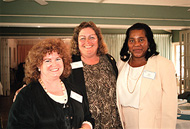![[Currents header graphic]](http://www.ucsc.edu/homeart/currents_header.gif)
![[Currents header graphic]](http://www.ucsc.edu/homeart/currents_header.gif)
October 19, 1998
California is facing a shortage of teachers that threatens to wreak havoc on the state's educational system. Fortunately, UCSC's New Teacher Project is ready to help.

|
|
(l to r) Barbara Davis of the New Teacher Project met with Kitty Dixon and Ann Nelson of the Franklin-McKinley School District at a Project open house. (more photos)
|
Current estimates are that the state will need 200,000 new teachers in the next decade, but experience shows that nearly half of all new teachers leave the profession within their first five years in the classroom.
That's where the New Teacher Project comes in. Now nearly 11 years old, the project provides critical support for new teachers during their first two years in the classroom. Exemplary veteran teachers are released full-time from their classroom assignments to serve as mentors, offering moral support, classroom management tips, assistance with lesson planning, and a myriad of other things that really make a difference.
New teachers typically begin their first year feeling confident and excited, but those emotions often give way to feelings of isolation, frustration, and disillusionment as difficult situations arise. With support, research shows, new teachers find their way more quickly and often avoid the low moments.
Indeed, 85 percent of new teachers who have participated in the Santa Cruz program are still teaching, said Ellen Moir, director of the project and director of teacher education in UCSC's Education Department.
"Our purpose is to help beginning teachers navigate their way through the first two years and to help them be successful," said Moir. "It's an effort that benefits new teachers, school districts, and ultimately the students, too, by improving the quality of classroom teaching."
The project's track record has helped it expand its influence beyond Santa Cruz County as well as to open a New Teacher Center in the McPherson Center in downtown Santa Cruz. Gary Bloom, former school superintendent of the Aromas-San Juan school district, was hired this fall as a third associate director of the center, joining Janet Gless and Wendy Baron. Together with assistant director Barbara Davis and a newly hired research staff, they will be working to help the project expand statewide.
The new center was made possible in part by a $1.1 million grant from the Walter S. Johnson Foundation, $175,000 from the S. H. Cowell Foundation, and $270,000 from the Noyce Foundation.
The expansion has enabled the project to extend its reach into several new school districts, including Aromas-San Juan, North Monterey County, Hollister, and this fall, Franklin-McKinley in San Jose and Gilroy. A total of 320 new teachers are participating this fall, said Moir.
"We wouldn't be moving over the hill if we didn't have a center," she said. "Part of the center's mission is to disseminate what we're doing. Our goal is to form a satellite center to serve the greater Silicon Valley and Bay Area."
A recent open house for interested school districts attracted representatives from districts in Walnut Creek, San Mateo/Foster City, Milpitas, Campbell, Lodi, and Hayward.
At the open house, officials from Franklin-McKinley School District expressed enthusiasm about joining the project--finally.
"We have been interested in this for 10 years," said Ann Nelson, assistant superintendent for educational services. "When we heard about the new center, we jumped at the opportunity."
Nelson's district has 45 teachers in their first year, as well as 48 emergency teachers who have not yet earned their teaching credential. "We're in desperate need of staff development and training," said Nelson. "Our superintendent, Larry Aceves, is very supportive of the Santa Cruz project. He's from Pajaro, and he's seen the difference it can make."
Districts contribute $2,100 per teacher per year, and the state contributes $3,000, said Moir. But the investment pays off, saving districts statewide millions of dollars by reducing the teacher dropout rate.
The Santa Cruz County New Teacher Project grew out of a three-year statewide pilot study funded by the California legislature in 1988. More than 35 programs emerged from that study, but the Santa Cruz project has endured, consistently earning high marks. Last May, the project was held up as a national model at a Chicago conference on recruiting teachers.
"This is the Cadillac version," said Franklin-McKinley's curriculum director Kitty Dixon, who is familiar with the project from her work with the Live Oak School District. "We do want the Cadillac."